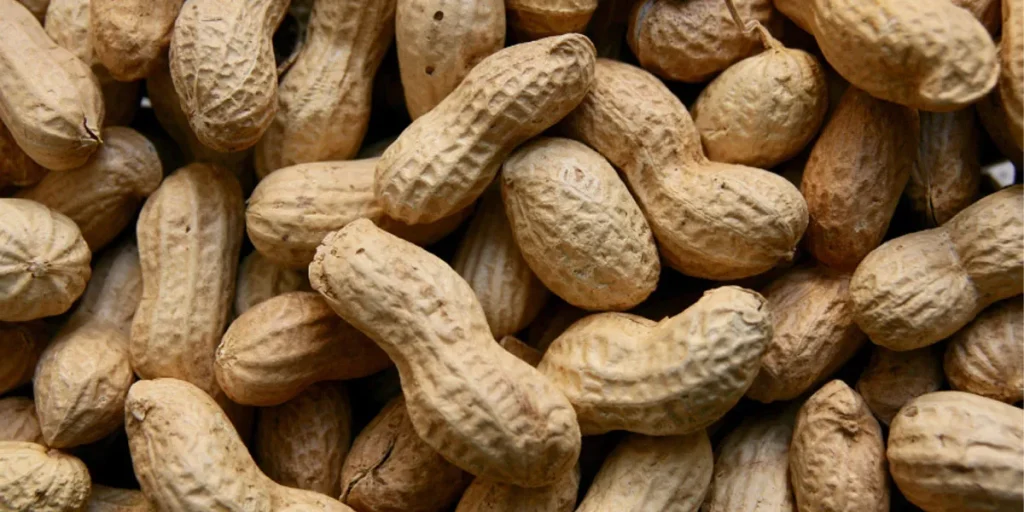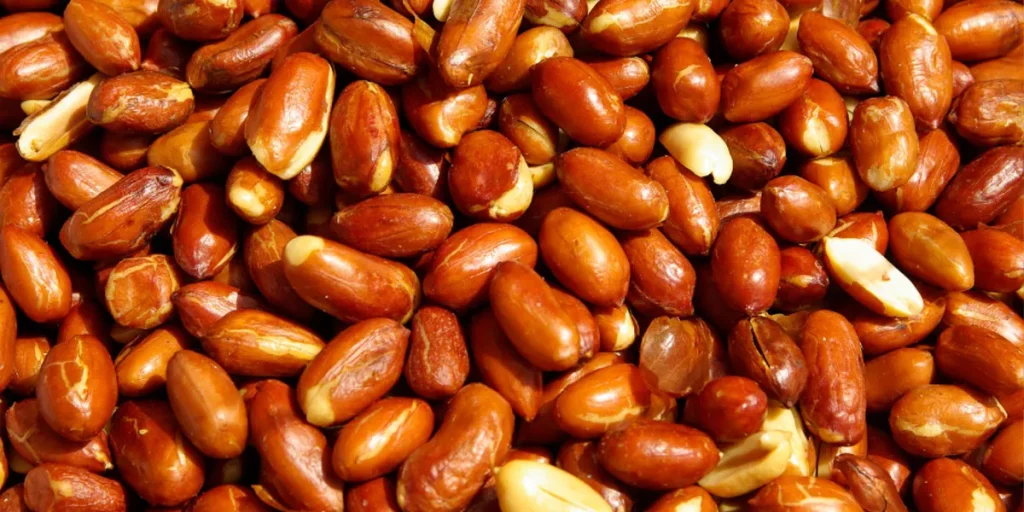An average shelled peanut weighs about 0.5 to 0.6 grams. A single unshelled peanut, by comparison, generally weighs around 2 to 4 grams.
Peanuts, known scientifically as Arachis hypogaea, are a staple in snack foods, cherished for their rich nutritional profile and versatility.
They are a protein-rich food, often seen in culinary applications ranging from peanut butter to various gourmet dishes.
Although small in size, peanuts pack a substantial punch in terms of both their caloric energy and cultural impact, being central to cuisines around the world.
Nutrient-dense and flavorful, they are a convenient, portable snack and a common ingredient across a myriad of recipes.
Their weight can vary based on the type and size, but for culinary and nutritional calculations, the approximate weights provided are typically adequate.
Peanut Basics
At a glance, peanuts seem simple. They hide in shells we crack open casually. Yet, these tiny powerhouses are full of surprises.
Each peanut weighs about 0.5 to 2 grams. This depends on their size, type, and moisture content.
The Botanical Identity
Peanuts have a special place in the plant world. Their scientific name is Arachis hypogaea. Despite the name ‘nut,’ they’re actually legumes. This means they’re cousins to peas and beans.
- Family: Fabaceae
- Genus: Arachis
- Species: A. hypogaea
Peanuts grow under the soil, which is unusual for nuts. Their growth cycle is fascinating. After flowering above ground, the flower stalk bends to bury the peanuts underground. This is where they mature.
Cultivation And Harvest
Peanut plants thrive in warm climates with well-drained soil. They need about four to five months of warm weather to grow. Farmers plant them in sandy soil and harvest after the leaves turn yellow.
| Month | Stage |
|---|---|
| 1-2 | Planting and sprouting |
| 3-4 | Flowering and pegging |
| 5 | Maturing and harvesting |
During harvest, machines lift the plants. They shake off the soil and reveal peanuts in all their glory. Farmers then dry them to reduce moisture. This protects the peanuts from spoilage.
Peanut Weight Variations

When it comes to peanuts, not all are created equal. Peanut Weight Variations can be quite intriguing. Several factors contribute to the difference in weight from one peanut to another.
Understanding these variations is not just important for farmers and sellers, but also for the curious minds who want to know more about this popular snack.
So, let’s crack open the shell and weigh in on the details.
Average Weight Of A Single Peanut
A single peanut has an average weight that might surprise you. Offering a rough idea:
| Type of Peanut | Average Weight |
|---|---|
| In-Shell Peanut | 0.5 to 0.6 grams |
| Shelled Peanut (Kernel) | 0.4 to 0.5 grams |
This gives a general baseline for peanut enthusiasts and peanut butter makers alike. Remember, these numbers are the average, so individual peanuts may weigh more or less.
Factors Affecting Peanut Weight
Several key elements play a role in determining how much a peanut will weigh. Consider these:
- Size of the Peanut: Naturally, larger peanuts weigh more than smaller ones.
- Moisture Content: Peanuts with higher moisture content can weigh more.
- Type: Different peanut varieties, like Virginia or Spanish, have distinct weight ranges.
- Growth Conditions: Soil quality, weather, and farming practices influence peanut size and weight.
Understanding these factors can help predict the weight of peanuts for cooking recipes, nutrition calculations, or bulk purchasing.
From Farm To Scale

Ever wonder about the journey of a peanut before it reaches your snack bowl?
Let’s unravel the process and learn how each step affects a peanut’s weight.
Harvesting Practices
Effective harvesting is the first critical step in determining the weight of peanuts.
Farmers wait for the right moment when the pods are mature.
They use specialized equipment to dig out and shake off excess soil.
- Maturity inspection ensures peanuts are at the right stage for picking.
- Precision equipment minimizes damage to the nuts.
- Soil removal affects the final weight measurement.
Drying And Processing Influence
Once harvested, peanuts undergo drying and processing. This step is vital to prevent mold and preserve quality.
Peanuts are air-dried to reduce moisture content, which directly impacts weight.
Final processing stages remove debris and grade the peanuts, ensuring consistent quality and weight.
| Stage | Process | Weight Influence |
|---|---|---|
| Drying | Air Flow | Decreases Weight |
| Processing | Cleaning & Grading | Standards for Weight |
Beyond The Shell
Ever wondered what really lies beyond the rough, textured coat of a peanut? Let’s crack open the nutty world of peanuts and explore their weight, both in and out of the shell.
Peanuts, a beloved snack, pack a punch of nutrients and flavor, making a journey from shell to scale an interesting tale.
Unshelled Vs Shelled Peanuts
On grocery shelves, peanuts appear both shielded by nature’s packaging and bare, showcasing their smooth, edible surfaces. Here’s a breakdown:
- Unshelled peanuts tip the scales with their protective outer layer.
- Shelled peanuts, free from extra weight, offer pure nutty goodness.
The weight of unshelled peanuts usually includes the shell, while shelled peanuts weigh less.
Weight Loss During Shelling
Peanut fans might notice that cracking open a peanut comes with a slight surprise—the weight drops. This is due to the removal of the shell.
| Before Shelling | After Shelling |
|---|---|
| Heavier due to shell | Lighter nuts alone |
On average, the shells make up 50-70% of the total weight of unshelled peanuts. This means shelled peanuts weigh significantly less than their unshelled counterparts.
Peanut Measurements In Culinary Uses
When cooking or baking with peanuts, knowing their weight and how to measure them correctly is crucial.
Peanuts come in various sizes, but on average, a single peanut weighs approximately 0.5 to 2 grams depending on its size and variety.
Precise measurements make a big difference in recipes. Let’s delve into the world of peanut measurements and conversions.
Volume To Weight Conversions
Converting peanuts from volume to weight helps in baking and cooking. Here’s a quick guide:
- 1 cup shelled peanuts – Roughly 145 grams
- 1 tablespoon shelled peanuts – Around 9 grams
An accurate kitchen scale is a baker’s best friend. It ensures your peanut measurement is on point.
| Volume | Weight |
|---|---|
| 1 cup | 145 g |
| 1 tablespoon | 9 g |
Peanut Butter Insights
Peanut butter’s weight varies from crunchy to smooth. It’s denser than whole peanuts.
- 1 cup smooth peanut butter – Weighs around 250 grams
- 1 tablespoon smooth peanut butter – About 16 grams
- 1 cup crunchy peanut butter – Slightly more due to chunks
For delicious results, use a kitchen scale to add the right amount of peanut butter to your recipes.
Economic And Nutritional Impact
The humble peanut, though small in size, carries significant weight in both the economy and our diets.
This tiny legume, usually weighing in at around 0.5 to 2 grams per nut, is a heavyweight when considering its economic value and nutritional density.
From fields across the globe straight to our snack bowls, the impact of the peanut is impressively vast and multifaceted.
Global Peanut Trade
With over 45 million tons produced yearly, peanuts play a critical role in global agriculture. Trading peanuts not only supports farmers worldwide but also fuels economies.
Significant exporters like China, India, and the United States contribute substantially to the industry.
Peanuts find themselves journeying across continents, placing them firmly at the heart of a global trade network.
| Country | Export (in million USD) |
|---|---|
| China | 250 |
| India | 100 |
| USA | 500 |
Health Benefits Per Gram
Peanuts pack powerful health benefits. Each gram combines proteins, healthy fats, and essential nutrients. Here’s how this tiny nut contributes to our well-being:
- Protein: For muscle repair and growth
- Fiber: For digestion and heart health
- Healthy fats: For brain function and lower cholesterol
- Vitamins and minerals: Such as B6, magnesium, and antioxidant-rich compound resveratrol
The nutritional impact is impressive, making peanuts a powerful ally in persistent snacking and balanced diets.
FAQ About the Weight of a Peanut
What Is The Average Weight Of A Peanut?
The average weight of a single peanut, with its shell, is about 0. 5 to 2 grams.
Shelled peanuts weigh less, typically ranging from 0. 3 to 0. 5 grams each.
How Many Peanuts Are In An Ounce?
There are approximately 28 to 30 peanuts in an ounce. This number can vary depending on the peanut size and whether they are shelled or unshelled.
Can Peanut Size Affect Its Weight?
Yes, peanut size directly affects its weight. Larger peanuts will weigh more than smaller ones.
Varieties of peanuts, such as Virginia, Runner, or Valencia, also differ in size and weight.
Do Roasted Peanuts Weigh Less Than Raw?
Roasted peanuts do weigh less than raw peanuts due to moisture loss.
Roasting can reduce a peanut’s weight by 15-20%, depending on the duration and temperature of the process.
Conclusion
In wrapping up, the humble peanut varies in weight, generally ranging from 0. 5 to 2 grams. Understanding this can enhance culinary accuracy and inform agricultural practices.
For peanut enthusiasts and professionals alike, grasping these details marks a step towards precision in various applications.
Keep this nugget of knowledge handy for your next peanut-related venture!
Resources:
https://www.ams.usda.gov/about-ams/facas-advisory-councils/peanut-board
https://www.federalregister.gov/documents/2024/02/20/2024-03371/peanut-promotion-research-and-information-order-continuance-referendum
